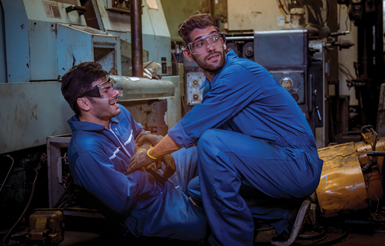Craftsman Cribsheet No. 132: Why You Should Care About Slips, Trips and Falls
Slips, trips and falls are becoming an increasingly cited regulation. Here’s how to minimize these hazards.
Slips, trips and falls cause nearly 700 fatalities per year and many more serious injuries, according to the U.S. Bureau of Labor Statistics. OSHA maintains regulations on walking and working surfaces for general industry in 29 CFR 1910.22-30 (bit.ly/PMPA-PM0924a). Slips, trips and falls are becoming an increasingly cited regulation. Let’s look at how to recognize these hazards.
Watch out for round objects. In our industry, we work with round bars every day. Leaving rolling objects on the floor is an accident waiting to happen. We often use floor dollies to move those bars around. Make sure the carts are returned to their proper place because nobody wants to step on a dolly and go sliding down the aisle. Do not just flip the dollies over. The cart has been stopped from rolling, but now the wheels become a tripping hazard.
Clean up fluid spills promptly. We have cutting oils, cutting coolants, lubricants, grease and the list continues. All of these become a serious hazard on walkways. Most shops have slick concrete floors for easy cleaning. Slick floors become even more slick when covered in fluids. Be mindful of spills and problem areas. Having available wet floor signs is a terrific way to alert operators to the problem. Also, if there is a machine that regularly leaks, put preventative absorbent mats down. This is a temporary solution until the root cause can be addressed.
Cords, cords and more cords. We deal with many types of cords. Airlines, extension cords, data cables and more become a hazard when in pathways. It is always best to route cords around pathways, but when that is not possible, take preventative measures to ensure safety. Use cable ramps to secure cords while still providing safe clearly marked transitions. If cable ramps are not available, secure the cords with a medium like tape or safety mat. Creating smooth visible transitions is key to reducing the hazard. Hanging cords can be a problem too.
Bundling all the cords in one group is best. Elevating them away from accessible areas reduces the hazard.
Keep aisleways clear. Aisles need to be clear for safety reasons. Having trip hazards in a fire, for instance, is dangerous. Keep chip trays, pans of parts, carts and toolboxes out of aisles. Use visual management like painted lines or tape to identify aisles. When aisles are clearly marked, everyone can see if there is a problem.
Make sure the lighting is appropriate. Good lighting is something we often take for granted. We flip the switch, and there is light. Be sure to assess multiple colors and forms of light to see what works best. Daylight LEDs are an easy way to provide good lighting at efficient costs.
Take a tour through your shop. Do you see hazards? The list above is not comprehensive. It does provide a starting point to make hazards visible. The first key to safety is recognizing the hazard. Once recognized, we can create solutions to eliminate them.
About the Author
David Wynn
David Wynn, MBA, is the PMPA director of technical services. He has over 20 years of experience in the areas of manufacturing, quality, ownership, IT and economics.
Email: dwynn@pmpa.org — Website: pmpa.org.
Related Content
Craftsman Cribsheet No. 128: Why Do Machinists Say Tenths Instead of Ten Thousandths?
In machinist parlance, a tenth is a tenth of a thousandth, not a tenth of an inch.
Read MoreTurned and Polished Steel Barstock: How It Is Manufactured, How It Impacts Your Shop
Understanding the benefits provided by turned and polished steel barstock and its differences from cold-drawn steel barstock can help you and your team avoid unexpected performance issues.
Read MoreCraftsman Cribsheet No. 129: How to Beat the Heat
Shops tend to heat up in the summer. Here are some tips for staying cool in the warmer months.
Read MorePrecision Ground Barstock: How It Is Manufactured, Benefits to Your Shop
Understanding the benefits provided by precision centerless ground barstock can help you avoid false economy and optimize the work you quote by maximizing benefits to your manufacturing process and customer.
Read MoreRead Next
A Tooling Workshop Worth a Visit
Marubeni Citizen-Cincom’s tooling and accessory workshop offers a chance to learn more about ancillary devices that can boost machining efficiency and capability.
Read MoreDo You Have Single Points of Failure?
Plans need to be in place before a catastrophic event occurs.
Read More5 Aspects of PMTS I Appreciate
The three-day edition of the 2025 Precision Machining Technology Show kicks off at the start of April. I’ll be there, and here are some reasons why.
Read More























